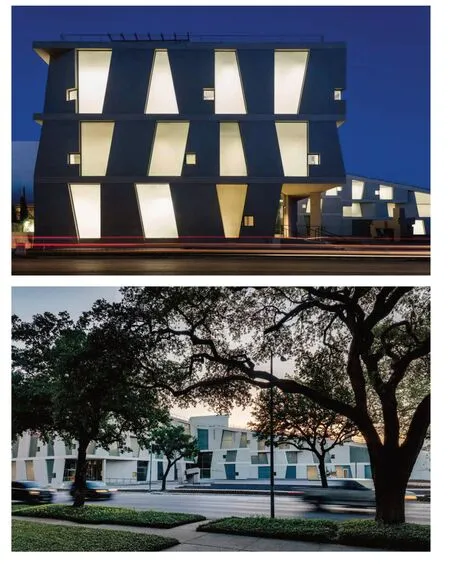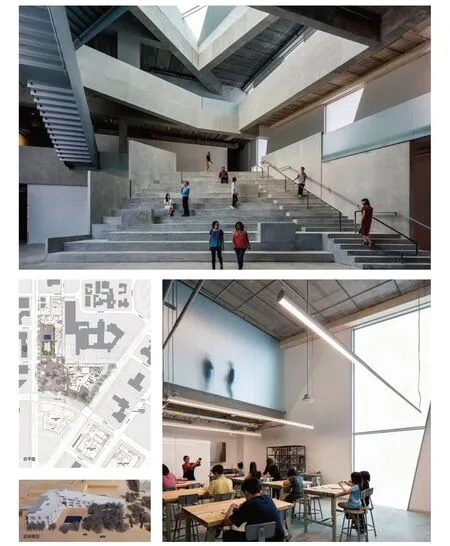休斯顿艺术博物馆美国德克萨斯州,休斯顿
建设单位: Glassell艺术学校
设计单位:史蒂文·霍尔建筑师事务所
设计团队:Steven Holl (主创设计) , Chris McVoy (团队主管),Olaf Schmidt (团队副主管), Rychiee Espinosa,Yiqing Zhao (项目设计师)
项目团队:Filipe Taboada, Xi Chen, Suk Lee,Maki Matsubayashi, Elise Riley,Christopher Rotman, Alfonso Simeo, Yasmin Vobis
合作单位:Kendall/Heaton Associates
结构工程:Guy Nordenson & Associates,Cardno Haynes Whaley
建筑面积:93 000平方呎,地下停车(两层)
时间:2011年至2018年
Client: Glassell School of Art
Architect: Steven Holl Architects
Design team: Steven Holl (design architect, principal) Chris McVoy (design architect, partner in charge), Olaf Schmidt (senior associate in charge), Rychiee Espinosa, Yiqing Zhao (project architect)
Project team: Filipe Taboada, Xi Chen, Suk Lee, Maki Matsubayashi, Elise Riley,Christopher Rotman, Alfonso Simeo, Yasmin Vobis
Associate architects: Kendall/Heaton Associates
Structural engineers: Guy Nordenson & Associates, Cardno Haynes Whaley
Building area (square feet): 93,000sf, Underground parking (two levels)
Year: 2011 - 2018
1) 建筑采用“L”形,定义了校园空间的几何形状。它与整个校园相连,并提供了通往校园俯瞰平台的斜面。
2) 结构:所用的预制混凝土构件在德克萨斯州韦科制造而成,它们与主斜面的角度相结合支撑起地板并对外部进行定义。同时,还与野口勇(Isamo Noguchi)设计的雕塑花园墙壁相互呼应。
3)“L”形建筑的入口位于主要内角处,通过结构的分解可以定义为:一个开放的空间设置了内旋的公共展览空间,可以垂直攀爬到屋顶的俯瞰平台上。
休斯顿艺术博物馆的再开发是一个独特的机遇,可以扩大博物馆园区,使其成为通向社区的整体体验。横向活动、透明性和多孔性将新的休斯顿艺术博物馆(MFAH)联合起来,提供了鼓舞人心和引人注目的公共空间。葱郁的休斯敦植被、清新的声音和水中的倒影都是新校园体验的组成部分,提升了艺术的诗意性。
“L”形的新格拉塞尔艺术学校塑造了布朗基金会广场,也扩充了野口勇设计的 Lillie & Hugh Roy Cullen 雕塑公园。
屋顶的倾斜面塑造了一个露天剧场和去往屋顶花园的公共通路,在那里可以俯瞰整个休斯顿艺术博物馆(MFAH)。
该建筑中包含 3 个长廊:1) 在一层的咖啡馆空间可以俯瞰广场;2) 教育大厅与雕塑隧道相连,通向未建成的 Nancy and Rich Kinder 大楼;3) 二层公共平台的顶部。
主入口通向不同高度的阶梯,塑造了一个公共空间,同时也是非正式的学习场所,可以直接通往配备了 75 个座位的礼堂。
其中,核心项目、初级学校和 8 个核心研究院工作室共享 23 个工作室。所有这些空间都是基于灵活适用、良好采光以及恰当尺度比例的原则来设计的。
简单的喷砂混凝土平面结构从屋顶倾斜面开始延伸,赋予建筑内部空间以密斯·凡·德罗(Mies Van der Rohe)原始建筑的简单和直接的精神。混凝土平面与大型半透明面板交替布局,为工作室提供理想的漫射光。作为一座教育建筑,它告诉我们它是如何建造的。温斯顿·丘吉尔(Winston Churchill)说过:“首先,我们塑造建筑,然后建筑塑造我们。”
1) The ‘L’ shape of the building is a campus space defining geometry, relating to the whole of the campus and providing the inclined plane access to the campus overlook terrace.
2) Structure: the precast concrete structural elements, made in Waco, Texas, hold up the floors and define the exterior, incorporating the angle of the main incline.They also allude to the adjacent sculpture garden walls angled by Isamo Noguchi.
3) The entry to the ‘L’-shaped building is placed at the main interior corner and is defined by a dissolution of the structure: an opening up which sets the exhibition forum in torsion climbing vertically to the roof terrace overlook.
The Museum of Fine Arts, Houston redevelopment has the unique chance to expand the museum’s campus as an integral experience open to the community.Horizontal activity,transparency and porosity will unify the new MFAH, and provide inspiring and inviting public spaces.The lush Houston vegetation, refreshing sound, and reflections in water are all part of a new campus experience elevating the poetry of art.
The new ‘L’ shaped Glassell school shapes the Brown Foundation Plaza which extends the space of the Lillie and Hugh Roy Cullen Sculpture Garden by Isamu Noguchi.
The inclined plane of the roof shapes an amphitheater and a public path to a rooftop garden overlooking the whole MFAH campus.
There are 3 gallery spaces in the building: 1) At the ground level café space overlooking the plaza; 2) At the Education Court connecting to a sculptural tunnel to the future Nancy and Rich KinderBuilding; 3) At the top of the forum on the second floor.
The main entry opens to a cascade of levels at the forum shaping an informal learning space directly opening to a 75 seat auditorium.
There are 23 studios shared between the Core Program and Junior School and 8 core-fellow studios.All of these have been designed with flexibility, great light, and fine proportions.
The simple planar structural pieces of sandblasted concrete begin with the angle of the inclined roof plane and give character to the inner spaces of the building in the spirit of simplicity and directness employed by Mies Van der Rohe’s original building.The concrete planes alternate with large translucent panels to provide ideal diffuse light to the studios.As an educational building it tells us how it is made.Winston Churchill said “First we shape our buildings, and then they shape us.”




